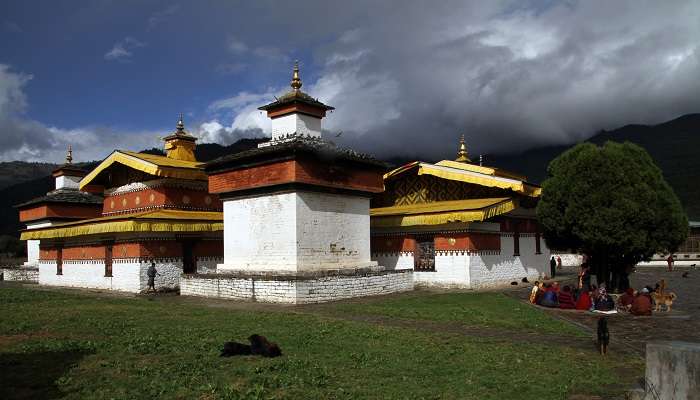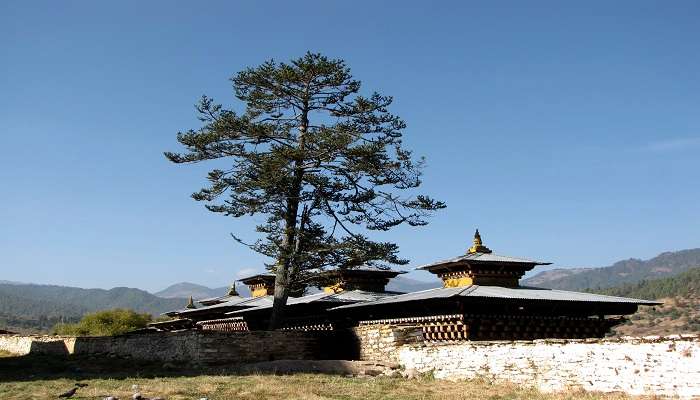Kurjey Lhakhang Is A Spiritual Oasis In The Bhutan’s Bumthang Region

Kurjey Lhakhang is one of the most sacred places located in Bumthang Valley. The temple derives its name “Kurjey” from the word body imprint, as it has a rock imprinted with Guru Rinpoche, the famous Buddhist master who helped introduce Buddhism to Bhutan in the 8th century. Set amidst green forests and calm rivers, the temple complex attracts many religious tourists and worshippers seeking solace. Kurjey Lhakhang Bumthang stands out because of its peaceful ambience and unending historical and cultural legacy. There are various inscriptions found inside, which makes this destination special for visitors.
History Of Kurjey Lhakhang

The history behind the establishment of Kurjey Lhakhang is filled with myth and spirituality dating back to the 8th century when Guru Rinpoche visited Bhutan. According to the legends, Guru Rinpoche arrived at Bumthang and subdued Shelging Karpo, who brought about instability in the area. The first temple was constructed by Minjur Tenpa -the Trongsa Penlop under the patronage of the first Zhabdrung Rinpoche, Ngawang Namgyal, in 1652, and it was named Guru Lhakhang. The Sampa Lhundrup was constructed in 1990 by one of Bhutan’s Monarchs.
Later, Tamshing Lhakhang was constructed by various Bhutanese kings and spiritual leaders during different periods. These additions indicate the continued devotion and significance attached to the place throughout the history of Bhutan. Many royal events and religious ceremonies occurred at this temple complex, which became a part of Bhutan’s cultural heritage. Each structure within this compound has its historical value, showing how religious changes and architectural improvements have enriched Bhutan’s artistic legacy through time.
Must Read: Bumthang In Bhutan
Architecture Of Kurjey Lhakhang

Kurjey Lhakhang is an architectural marvel that captures the essence of Bhutanese design and artistic works. The complex consists of three main temples, each representing a different style. The oldest one, Guru Lhakhang, possesses traditional Bhutanese architectural elements such as intricately carved woodwork, ornate sculptures and vibrant frescoes. This temple also contains a sacred rock with Guru Rinpoche’s body imprinted alongside statues and murals depicting various Buddhist deities and legends.
The second temple, called Sampa Lhundrup Lhakhang, is known for its beautiful murals as well as its collection of statues, including an impressive depiction of Guru Rinpoche in his wrathful form. Tamshing Lhakhang has a construction style that blends modern and traditional Bhutanese ways of making temples, reflecting how the country has changed over time. While pictorial illustrations of ancient Buddhist stories enrich exterior walls, interiors are full of numerous thangkas (religious paintings), statues and other sacred items used for worship.
Places To Visit Near Kurjey Lhakhang Bumthang
Kurjey Lhakhang is surrounded by several other historical-cultural landmarks, which provide deep insights into the rich heritage and natural beauty within this locality. Each site tells a unique story woven into Bhutan’s spiritual and historical tapestry, ranging from ancient fortresses and temples to serene lakes and monasteries. Visiting these places gives a comprehensive view of Bhutanese culture, its religious underpinnings, and the natural beauty surrounding these sacred destinations.
1. Jakar Dzong

Jakar Dzong, also known as Jakar Yugyal Dzong, is in the Chamkhar valley of Bumthang. The fortress was built in 1549 by Tibetan lama Ngagi Wangchuk as a defensive stronghold for the eastern dzongkhags of Bhutan. The name Jakar has been attributed to “bjakhab” which means a white bird, referring to a myth of a white bird signalling where the monastery should be situated. It served as a place for Bhutan’s first king in 1646 after witnessing significant historical events over centuries. Despite damages caused during Tibetan invasions in the 17th century, it was repaired, symbolising resilience and spiritual importance.
Visiting Hours: 09:00 AM – 05:00 PM
Entry Fees: No charges
Suggested Read: Bhutan Hill Stations
2. Jambay Lhakhang

This ancient temple, situated at Bumthang, was built in 659 CE by the Tibetan King Songtsen Gampo to spread Buddhism. It is one of 108 temples constructed throughout Bhutan. Padmasambhava visited it when he revived life in Sindhu Raja’s body. Through the ages, Jambay Lhakhang has undergone many renovations, which have preserved its sanctity and architectural splendour. Many festivals are celebrated at this place. Still, the most popular one is the Jambay Lhakhang Drup festival, where dance and religious ceremonies attract tourists from all over the world.
Visiting Hours: 09:00 AM – 04:00 PM
Entry Fees: No charges
3. Wangduechhoeling Palace

Wangduechhoeling Palace is situated on 20 acres of land in Bumthang, which shows its royal heritage and architectural excellence. It was initially the residence of Ugyen Wangchuck (Bhutan’s first king) before being meticulously renovated by dedicated local conservationists. Restoration efforts have also provided opportunities for local artisans involved in traditional art. The museum contains a rare collection consisting of artefacts like paintings, manuscripts, and religious relics, thereby enabling visitors to immerse themselves in Bhutan’s history and culture. Interactive displays and audiovisual presentations recreate the past in a vibrant form. This palace premises harmoniously combines spirituality with history and the natural environment.
Visiting Hours: 10:00 AM – 05:30 PM
Entry Fees: INR 230 (for Indians), INR 460 (for Foreigners)
Suggested Read: Tourist Places In Bhutan
4. Ngang Lhakhang

Ngang Lhakhang is a hidden gem in Bumthang Valley, a temple built in the 15th century by Lama Namkha Samdrup. It was established as Swan Temple when the Lama saw a swan landing at this place as a sign from God. It is designed like a big farmhouse resembling the surrounding rural landscape. The lower temple has beautiful statues of Guru Rinpoche with his consorts, while the upper one consists of masks used in religious festivals and protective deities. Every year during the 10th month of the Bhutanese calendar, the community celebrates the Ngang Lhakhang festival with dance and prayers.
Visiting Hours: Throughout the Day
Entry Fees: No charges
5. Chakhar Lhakhang

Chakhar Lhakhang, also known as Iron Palace, is an old temple constructed by Saint Dorji Lingpa in the 14th century AD. The Temple was built at King Sindhu Raja’s palace on a plateau facing a river in Bumthang. The original palace was made of huge iron, giving rise to its name, Chaka, which means iron palace in the Bhutanese language. There are many significant religious treasures and antique relics stored here. Chapels also contain murals and paintings dating back to the fifteenth century. A caretaker, also a descendant of Dorji Lingpa, takes care of the temple.
Visiting Hours: Throughout the Day
Entry Fees: No charges
Further Read: Backpacking In Bhutan
To truly understand Bhutan’s spiritual heritage, visit Kurjey Lhakhang. The spiritual environment here will not only revive your mind but also help you reconnect with your inner self, as it is surrounded by lush greenery. Therefore, if you are looking for serenity, book a trip to Bhutan and experience pure bliss at this monastery.
For our editorial codes of conduct and copyright disclaimer, please click here.
Cover Image Credit: Christopher J. Fynn for Wikimedia Commons
Frequently Asked Questions About Kurjey Lhakhang
Who discovered Kurjey Lhakhang?
Kurjey Lhakhang was discovered by Guru Rinpoche who also went by the name Padmasambhava during his visit to Bhutan in the 8th century AD.
Why was Kurjey Lhakhang built?
Kurjey Lhakhang was constructed to commemorate the place where Guru Rinpoche meditated indicating his contribution towards the expansion of Buddhism in Bhutan.
What festivals are celebrated at Kurjey Lhakhang?
This temple has numerous religious celebrations with the most important being Kurjey Tshechu which comprises traditional dance and rituals dedicated to worshipping Guru Rinpoche.
What is the best time to visit Kurjey Lhakhang?
Consider visiting this place during spring and autumn when the Bhutan weather is favourable, and many festivals are celebrated
What should visitors wear during their visit to Kurjey Lhakhang?
Visitors should wear modest attire that covers their shoulders and knees as a way of showing respect to this holy place.
People Also Read:
Paro Taktsang Chimi Lhakhang Jakar Dzong

Passionate Marketing Student with a flair for storytelling, eagerly embarking on a journey within the vibrant world of travel. Excited to merge analytical acumen with creative skills to elevate the editorial landscape of the travel industry.











